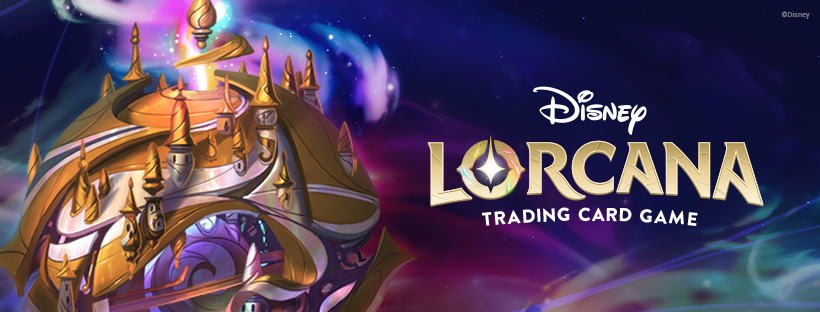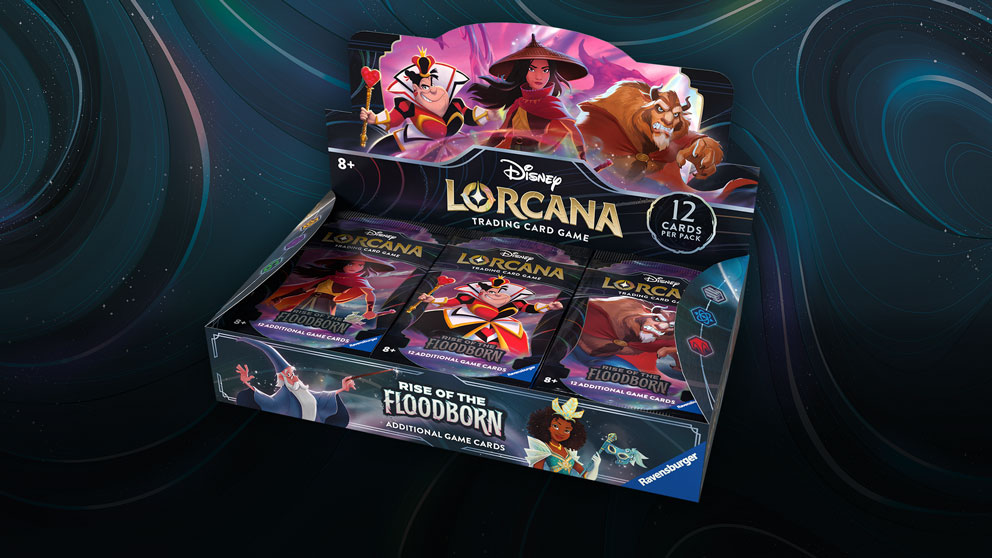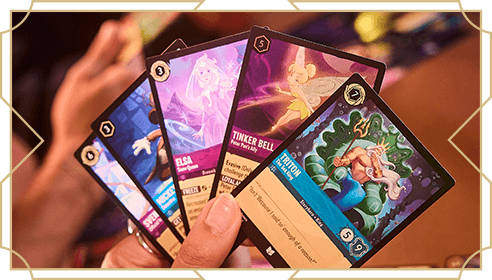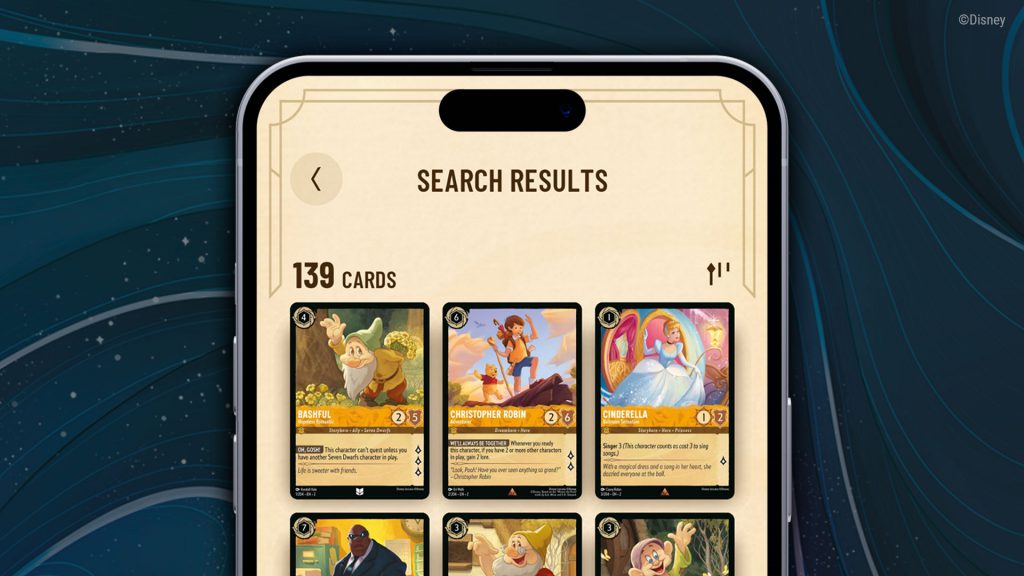As I write this review, it’s been just a couple of weeks since Lorcana’s second set, Rise of the Floodborn debuted in a limited, LGS-focused release ahead of its 12/1 general release a big-box stores. The release was an absolute disaster of John Carter magnitude but unlike that notable Disney flop nobody waited in an online queue for nine hours to be told that a “massive DDOS attack” (chuckle) was shutting down the whole thing. And I’m pretty sure nobody was paying 200-300 percent markups for John Carter tickets.
Given that the initial release was also very much an ess-aich-eye-tee show as well, and reflecting on how the only way my family and I have gotten cards is pretty much through faith, trust, and pixie dust (along with lots of driving), I’ve got to ask myself “was this Mickey Mouse card game worth all of this stress, disappointment, and effort?” The answer I keep coming back to is yeah, it actually kind of is. So I suppose we are going to call this Mikey Mouse Club the official Michael Barnes review of Lorcana- I’m not sure I was ready to put it down to paper before Rise of the Floodborn, but now I feel like I have a more complete picture of this game and its scope. So far it’s a been a joy to play and collect- apart from, you know, actually being able to buy it.

The Great Illuminarium. Where Illumineers illuminate. Or something like that. (Ravensburger)
As a game that may have more appeal to collectors than other TCGs, there’s plenty to offer outside of the game. There’s some storyline blah blah to do with an ink flood and Illumineers (not to be confused with employees of Illumination Studios) I don’t know what all else. But the main thing to know is that there are three types of Disney characters on display in the cards- Storyborn characters are the “classic” versions, Dreamborn are the characters’ idealized selves, and Floodborn which are kind of alternate universe takes. So there’s a Belle that’s the yellow-dressed bookworm we know and love, one that is a steampunk-ish engineer, and another that is an archer with a quiver full of rose arrows. There are some really fun concepts for the characters throughout the cards, I’m particularly fond of the chic Cruella in an art deco roadster and a Cinderella appearing as a heavy plate wearing knight complete with a pumpkin-festooned sword. The artwork is almost uniformly great with just a few stinkers (Judy Hopps isn’t looking her best), and the graphic design is attractive, modern, and on the right side of timeless. It all looks a far sight better than, say, any of the anime card games out there.
As for the gameplay, In many ways, Lorcana feels very much like a “greatest hits” package of TCG design concepts and as such I think veteran players will fall into two camps: one, those who call Emperor’s New Clothes on the whole thing and don’t get it and two, those who appreciate the degree of thoughtful refinement and elegant streamlining that Ryan Miller and his team have put into this game. Newcomers who aren’t approaching the game with expectations will find an immensely accessible, approachable game with clean rules and a degree of clarity that is remarkable for any game with at this point 408 cards.
Decks are 60+ cards, requiring the use of one or two of six Ink colors. Ink is the game’s resource, and there are “Inkable” and “Uninkable” cards. Inkable cards can be placed face down in an Inkwell once per turn, Uninkables can only be inked by card effects. There’s no “mana screw”, but it is entirely possible if you are not careful that you can be ink screwed if you put too many Uninkable cards in your deck.

More like “unbuyable” amirite. (Ravensburger)
Each Ink color has certain advantages and general concepts, but there is also a lot of crossover. Sapphire has a lot of ramping, for example, but Amber also has cards like Lantern (from Tangled) and Just in Time (featuring Maui) that offer ramp in that color. Ruby is lots of aggro-oriented fighters, but every color has some solid choices for board control. Emerald is all about tricky stuff like bouncing, stealing, and discards but Amethyst has some of that as well among its combo-focused options. Synergies between each color abound, and the deckbuilding is quite compelling. You can go for a mechanically sound metadeck or work up a one based on a particular theme or set of characters you like. I’ve been running a really fun Emerald/Sapphire deck I’m calling Belle and Flynn’s Big Score that’s all about those characters doing crimes along with Robin Hood, Nick Wild and Duke Weaselton (the latter two from Zootopia), while being pursued by Detective Mickey and Basil from the Great Mouse Detective. Caterpillar (from Alice in Wonderland) even shows up to play saxophone for the love scene.
But that deck probably won’t win because there is some real depth to the game. To win, you have to hit 20 Lore. You do this by exerting characters to Quest. Most have one to three Lore that they can fetch for you, some have special conditions like the Flynn Rider I’m running in the deck above, he has four Lore but gets -1 for each card in the opponent’s hand. Essentially, the game is a race, and to win that race you must balance Questing with Challenging the opponent’s exerted characters. Board control and tempo are everything in this game, and tough decisions abound about when to Quest or when to Challenge- or when to hold off and not exert anything at all. Challenging is the basic A/B versus X/Y removal thing just like Magic, but it’s a direct one on one combat between the challenger and an exerted (tapped) character.

A pretty unrealistic stock pic. Nobody plays with Sven, that version of Tinkerbell, or Triton. (Ravensburger)
There’s a wide range of statlines to consider when putting a deck together along with special card abilities that come into play. I’m especially fond of the new Resist mechanic in Rise of the Floodborn, which gives characters damage reduction- it’s amazing how many times -1 damage keeps a character on the board.I also like the Shift mechanic, which is essentially an update to the ol’ Pokemon evolution thing. Floodborn characters all have it, and it allows you play them on top of existing characters with the same name at a discount. This can be huge- for example, playing a 3-drop Tinkerbell, Tiny Tactician opens the way to play a 6-drop Tinkerbell, Giant Fairy and possibly clear the board on turn 4.
It’s all fun, sometimes thrilling, and despite the best efforts of some “Mr. Suitcase” types and alpha gamers (we’re never getting rid of them, are we), it tends to remain casual while still having enough guts and grit to offer challenge. The complexity level is just right- it is absolutely not a dumbed down game, rather it is very smarted up.
Not to put too fine a point on it, Lorcana is the best TCG I have played since Magic: The Gathering. I didn’t quite feel like that a month ago because The First Chapter seemed like it was missing some things among its 204 cards. Once the meta settled in, a couple of key deck types pretty much completely dominated (Amber/Steel Steelsong and that godforsaken Ruby Amethyst thing where Elsa shows up at the end to give you the big L hand). It also seemed like certain deck types weren’t possible or were kind of half-possible given the selection of cards. At League, I repeatedly heard “I think (deck type) isn’t quite there yet”. And as someone who struggled through most of the first release cycle trying to Sapphire Steel ramp, I felt that for sure.

The app is quite well done, and I’ve found it essential for collecting and deckbuilding (Ravensburger)
And all of this is without taking into consideration anything other than constructed and starter deck play. Having played a few multiplayer games, the game takes on a whole new world of possibilities- I think it is uniquely suited for three or more players, and many cards clearly reference playing with multiple opponents. I’m also eager to see how this game drafts once cards are more available- there’s tons of cards that aren’t that great now, but could be significant in a draft environment.
So yeah, after all is said and done, Lorcana is worth it.
Next time: How to play Lorcana without struggling to buy cards.
Have any questions or feedback? Drop us a note in the comments below or email us at contact@goonhammer.com.



You must be logged in to post a comment.